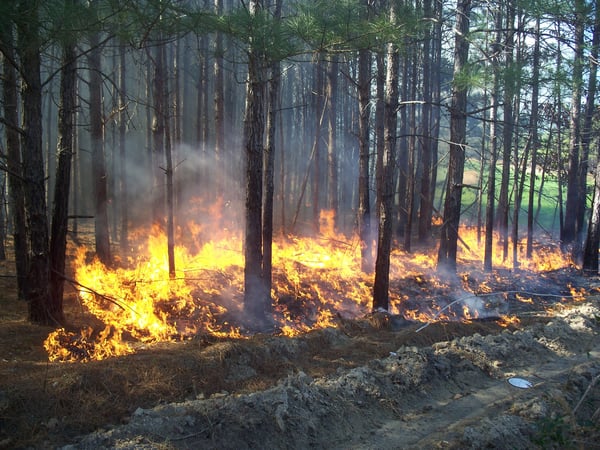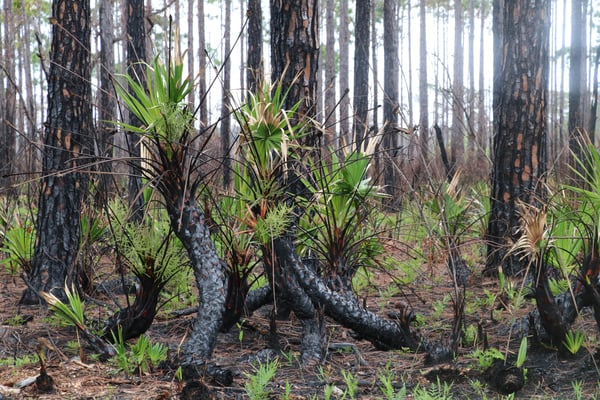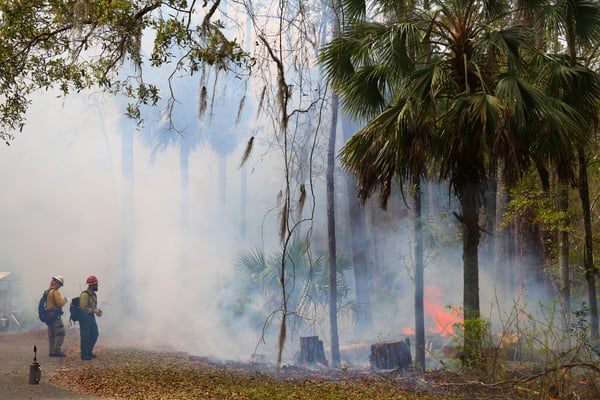The relationship between fire and our earth, go way back. Earth contains the essentials for fire: oxygen, fuel, and an ignition source, as well as an extinguishing agent: moisture.
Many of our forests were molded by fire. Early humans used fire to drive game for harvest, attract game after a post-fire green up, and as protection from predators. Today, fire sets back forest succession to earlier stages, and prescribed fire remains a valuable tool for forest management.
What are Prescribed Burns?
Prescribed burns—also known as prescribed fire, controlled burns, and managed fires—are fires that are set on purpose to accomplish certain goals in your woods. These fires burn at a relatively low temperature, and they’re closely monitored and managed so they don’t get out of control.
 |
| Example of a headfire burning along a firebreak. |
Note: In some states, it's common practice for landowners with appropriate equipment and training to conduct prescribed burns on their own land. In others, especially where wildfire risk is significant, or where state laws and insurance is prohibitive, it's highly recommended that individuals work with their state agency or another local partner to ensure the burn is done safely and with the correct permits. Do your research before planning your own burn.
The Benefits of Prescribed Burns:
- Clearing dead trees, leaves, branches, and competing vegetation from the forest floor, so new plants can grow and healthy trees can flourish
- Controlling the amount of available fuel in your woods, to reduce your risk of a dangerous wildfire
- Controlling unwanted trees/plants and invasive species
- Breaking down and returning nutrients to the soil to improve its productivity
- Releasing seeds and stimulating the growth of fire-dependent tree species, such as lodgepole pine
- Promoting wildflower and plant diversity
- Improving wood quality for species such as longleaf pine when the lower limbs are "pruned" by the fire
- Controlling some insects and disease
- Improving wildlife habitat by enhancing or maintaining open areas (like prairies or meadows) and encouraging the growth of wild food plants and forage
 |
| The results of a prescribed burn in Crawfordville, FL |
Prescribed Burning for Wildlife Habitat
When author and wildlife biologist Dr. James Dickson enlisted other forestry experts to contribute to his book, Wildlife of Southern Forests, he took note of how many recommended fire for their designated species.
The answer? Many.
The red-cockaded woodpecker, northern bobwhite, American woodcock, reptiles and amphibians, deer, turkeys, and other grass-forb associated birds were among the long list of species said to benefit from prescribed fire as a habitat improvement practice.
When planning a prescribed burn with wildlife in mind, remember that not all fuel is created equal. Southern pine trees for instance, typically have thicker, better insulating bark than their hardwood counterparts, which protects them from the heat of the fire. This means that prescribed fire can be very effective at eliminating smaller competing hardwoods.
Having said that, hardwood litter must be much dryer than pine needles in order to carry a fire. Of course there are exceptions to every rule, for instance the Bur Oak, which evolved in the Prairie systems and developed an insulating bark. For this reason it's best to research the tree species unique to your property before planning a burn.
Tips for Conducting a Prescribed Burn:
- There are two seasons for burning. In dormant season (winter) much of a small tree’s nutrients are below ground, so protected from heat. Growing season fires have more impact on small trees that are leafed out, but may consume ground nesting bird nests. Flame height and the duration flame is in contact with fuel and trees is the main determinant of impact.
- Be sure you have good firebreaks. Use natural features such as streams or roads when possible, or remove ground litter to exposed soil.
- Back fires backing into the wind are usually set first. Be sure you get enough consumed fuel and black line to keep the headfire set later from jumping the firebreak.
- Recommended relative humidity is usually between 30-60%. Humidity is usually highest about daybreak and lowest mid afternoon.
- Modest wind, about 4-12 mph, can move the fire without excessive hazard.
- Tools you will need include: a sprayer (capable of 125 pounds-per-square-inch pressure and at least an output of 6 gallons of water per minute,) a drip torch for ignition, a fire rake, flaps, a leaf blower, and a tractor or bulldozer capable of making firebreaks is a nice backup.
- Wear nomex or natural materials, like cotton or wool, and leather boots and gloves, because synthetic materials can melt onto your skin and cause burns if they catch fire. It also pays to wear eye goggles, face masks, and hard hats.
The best tip we can give is to do your research and be careful. Find out what permits are required in your state, and get professional help if you are new to prescribed burning. Many local forestry agencies offer Learn & Burn events where landowners can get first hand experience with prescribed fire before doing it themselves.
|
|
St. Marks National Wildlife Refuge firefighters executing a prescribed burn in Florida. |
Additional Resources
Below is a list of resources to get you started on understanding and planning a prescribed burn in your region:
Planning & implementing a prescribed burn (Downloadable Guide from Iowa State University)
Planning & performing a prescribed burn (Video series from Iowa State University)
Personal Protective Equipment Overview (North Carolina State University eFire interactive site)
The Benefits of Prescribed Burning on Private Land, (Guide from the Minnesota Department of Natural Resources)
Using Fire to Improve Wildlife Habitat (Guide from the North Carolina Cooperative Extension Service)
Association for Fire Ecology (Improves the knowledge and use of fire in land management through science and education)
National Interagency Prescribed Fire Training Center (Their program blends field prescribed burning experience with curriculum of classroom instruction)
Prescribe Fire Councils (Open to all prescribed burners - offers information-sharing and networking opportunities for individuals, agencies, and organizations through annual or biannual meetings )
Southern Fire Exchange (Regional program for fire science delivery in the Southeast.)
Tall Timbers (Fire Ecology Program improves management for conservation of natural ecosystems through scientific research and outreach regarding the role of fire in natural plant communities)
*This Tip for Landowners was written by Dr. James G. Dickson, award-winning author, researcher, wildlife biologist, and professor, in collaboration with the American Forest Foundation team. Dr. Dickson, with help from colleagues produced the most comprehensive and award-winning books on: Wildlife of Southern Forests: Biology and Management, and The Wild Turkey: Biology and Management. He is Scientist Emeritus, USDA Forest Service, Southern Research Station. Reach him via email him at jgdickson14@gmail.com.



We want to hear from you.